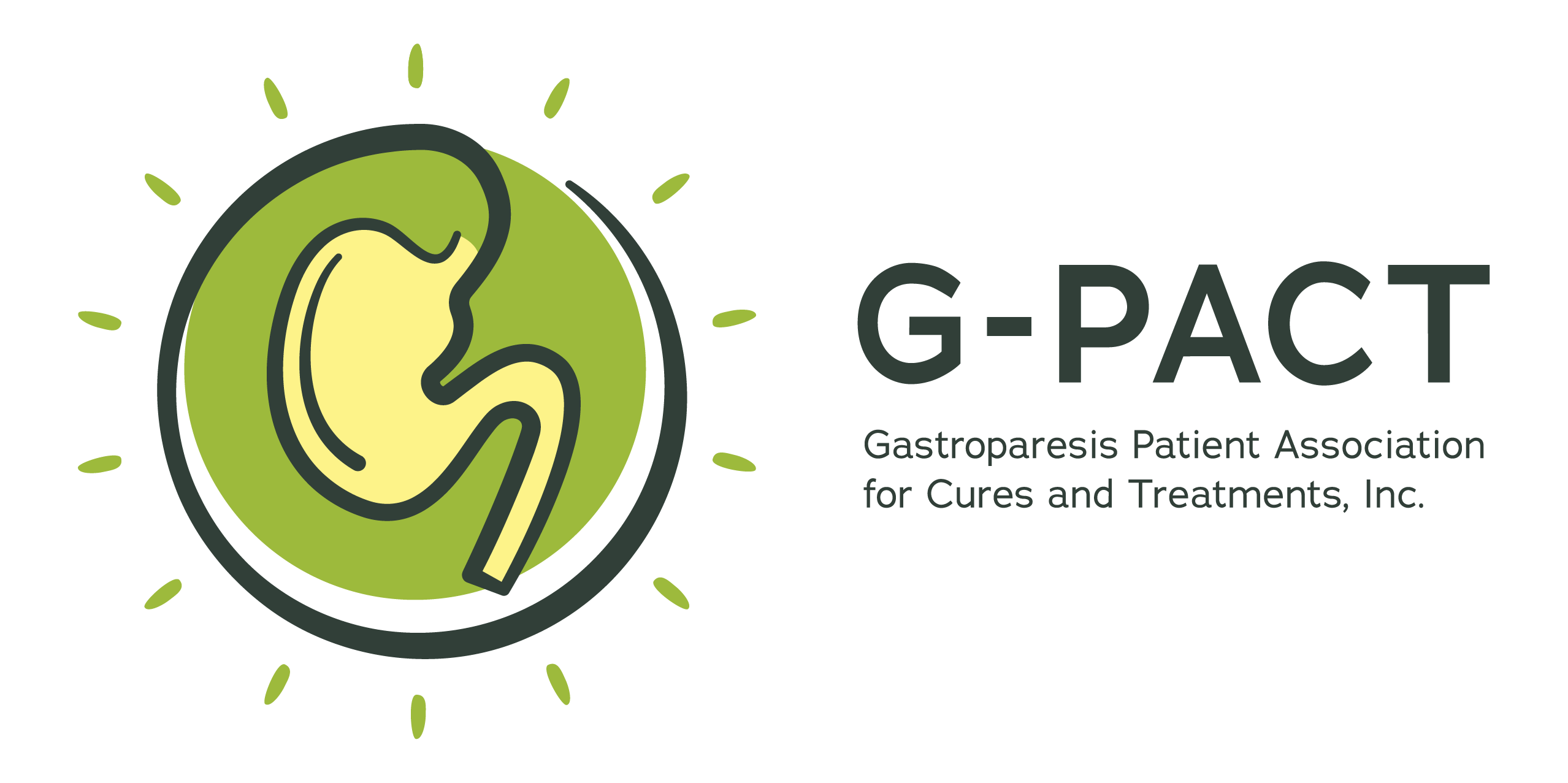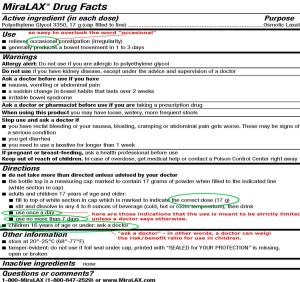Is Miralax Safe?
by Jim Sliney Jr, RMA 1/22/2015 ©
Miralax is an osmotic laxative. What that means is it draws water into the colon from surrounding tissues to lubricate the colon and encourage bowel movement. Milk of Magnesia is also an example of an osmotic laxative though it relies on magnesium while Miralax and several similar products rely on something called polyethylene glycol 3350.
Let’s go to school before we go any further.
There are several different types of laxatives on the market [1]:
| TYPE (with some examples) | How they work, basically | What potential side effects |
| Osmotic laxatives
(Milk of Magnesia, Miralax, GoLytely, Colyte, Moviprep) |
Draw water into the colon from surrounding tissue to ease the passage of stool | Bloating, cramping, diarrhea, nausea, gas, increased thirst |
| Bulk formers
(Benefiber, Citrucel, FiberCon, Metamucil) |
Absorb water in the colon to form soft stools that can pass naturally | Bloating, gas, cramping, or increased constipation if not taken with enough water |
| Oral stool softeners
(Colace, Surfak) |
These add moisture to stool easing the strain of bowel movements | Electrolyte imbalance with prolonged use |
| Sodium phosphate or biphosphate
(Fleet, Visicol, Osmoprep, Pedia-Lax) |
Like osmotics, draws water into the colon, but may not be appropriate based on medical history | Dehydration and electrolyte imbalance with over use |
| Lubricants
(Mineral oil) |
Mineral oil that lubricates the lining of the intestine | Leakage, irritation/itching around the anus |
| Oral Stimulant
(Dulcolax, Senokot) |
These trigger peristalsis (normal intestinal contractions) to move stool | Belching, cramping, diarrhea, nausea, urine discoloration |
| Rectal Stimulant
(Bisacodyl, Pedia-Lax, Dulcolax) |
Like oral stimulants but used when constipation occurs in the rectum or lower large intestine | Rectal irritation, stomach discomfort, cramping |
Laxatives risk interfering with intestinal absorption of nutrients and minerals by speeding up or changing the nature of the behavior of the intestine. Think about it, you take your laxative and it brings in more water, or it over stimulates peristalsis, in either case interrupting the “normal” functioning in the gut whose #1 job is to absorb useful things from the food we eat, the #2 job of course being to get rid of waste. [Pause for chuckle]. So if your bowels are moving too fast or too slow absorption suffers which is why some laxatives add electrolytes to compensate.
The recent debate:
In 2012 the Empire State Consumer Project operating out of Rochester NY convinced the Food and Drug Administration to re-open an investigation into PEG 3350 (“Polyethylene Glycol 3350”) an ingredient in osmotic laxatives such as GoLytely, Colyte, Moviprep, Pegalax, Lax-A-Day, Restoralax and Miralax that could potentially be harmful to children.
The concern is that the active ingredient PEG 3350 might be harmful to children somehow. Miralax, the most widely recommended laxative, is for adults yet it is often prescribed for children to treat constipation or fecal impaction or is used for bowel cleansing. Furthermore, it is often taken longer than prescribed or at doses meant for adults. PEG 3350 is supposed to stay in the intestines to attract water in, but children’s intestines function differently and the concern is that children might absorb the Polyethylene Glycol 3350 into their bodies.
What’s so bad about Polyethylene Glycol 3350? No one, including the FDA, is sure. The FDA raised questions in 2009 about whether PEG would be absorbed more in children but did not state what the risk was. My best efforts found nothing specific, and that is why the FDA has agreed to sponsor a study to investigate it.
So what are some experts saying about this Polyethylene Glycol 3350 issue in laxatives:
In an article in the New York Times Science section from January 5, 2015, “Dr. Robert O. Heuckeroth, a principal investigator and a pediatric gastroenterologist at The Children’s Hospital of Philadelphia says, “We think we know what’s in the medicine itself, but in the body, once you take it, it could potentially do something” [1]. A bit vague perhaps, but clearly an argument for studying it more carefully, which is precisely what he is doing.
In an online article from WBUR Boston on January 16, 2015, “Dr. Samuel Nurko, director of the Center for Motility and Functional and Gastrointestinal Disorders at Boston Children’s Hospital, said parents have little reason to worry. Dr. Nurko, who was involved in previous studies of Miralax, some partially funded by the drug company that used to own Miralax, argues that the drug isn’t approved for children because of the technicalities surrounding the FDA study process. He believes Miralax is safe for children.”
“Just because the FDA is doing a study, doesn’t make it dangerous…. From my perspective, the risk of not treating constipation is worse. Do you think the FDA would leave it on the market if it were dangerous? I think it’s an overreaction but I’m glad that they are studying it.” [3]
In these and other references I found it was rather clear that Miralax is thought of as an effective laxative with mild side effects when taken as directed. It has even been quite effective as a laxative in children, despite the investigation taking place into the effects of PEG 3350 on children.
So is Miralax safe or not?
The company that manufactures Miralax (Bayer) contends that it is safe when “used as directed”. Like me, you’ve probably heard that term so many times that it doesn’t mean anything anymore. Still, let’s find out how Miralax directs its own use.
There is no better place to start than the Drug Label on the packaging. These labels really do have most of the vital information one needs to use safely. As we read over this, remember, all companies choose the wording on these labels carefully.
Hmmn…How would you define “occasional”? How tempted would you be to use more than 17g? Would you give this to your child without asking a doctor? The rules and restrictions on these drug labels come from years of research, and from known and unknown risks-and-benefits as determined by the NIH, the FDA and the company that manufactures the drug. And because of ongoing studies and findings, this information changes from time to time. So my advice is, since companies write them very carefully, you should always read these labels very carefully.
RxList.com shows that Miralax has been studied exhaustively. The site has summaries of the studies but the bottom line is that it has been found to be very effective as a laxative and produces very few side effects. [4]
Rxlist.com also points at the common side effects of Miralax which are:
- Nausea
- Abdominal bloating
- Cramping
- Flatulence
- Diarrhea (when using larger doses)
- Excessive stool frequency (particularly in elderly nursing home patients)
- They also state that “Patients taking other medications containing polyethylene glycol have occasionally developed urticaria (aka ‘hives’) suggestive of an allergic reaction”. [5]
These side effects are not unusual especially when you look at the side effects of ANY other laxative product – the lists are pretty similar.
Risks versus benefits
When a doctor considers putting someone on a laxative, like with most medical decision-making, they weigh the potential side effects of a treatment against the effects of the condition. Miralax is highly recommended presumably because the medical community thinks the effects it brings about are greater than the risks of taking Miralax. Like Dr. Nurko said earlier, “the risk of not treating constipation is worse”.
Regarding laxatives in general, the Mayoclinic says, “Laxatives can help relieve and prevent constipation. But not all laxatives are safe for long-term use. Overuse of certain laxatives can lead to dependency and decreased bowel function.”
So is Miralax safe for me? Is it safe for my children?
It seems to be safe for adults, yes. Whether it is truly safe for children will be determined by the FDA’s study. But like any drug, whether over-the-counter or not, you should consult with your doctor before using it because you or your child may have other conditions or be on other medications that could complicate that carefully balanced risk-benefit ratio. And you should do some research of your own starting with the careful wording of the Drug Label and ending with reputable sources.
Resources:
| [1] | [Online]. Available: (http://www.mayoclinic.org/diseases-conditions/constipation/in-depth/laxatives/art-20045906). |
| [2] | [Online]. Available: (http://www.nytimes.com/2015/01/06/science/scrutiny-for-a-childhood-remedy.html?_r=0). |
| [3] | [Online]. Available: http://commonhealth.wbur.org/2015/01/miralax-dilemma-parents-safe. |
| [4] | [Online]. Available: http://www.rxlist.com/miralax-drug/clinical-pharmacology.htm. |
| [5] | [Online]. Available: http://www.rxlist.com/miralax-drug.htm. |
| [6] | [Online]. Available: (http://www.mayoclinic.org/diseases-conditions/constipation/in-depth/laxatives/art-20045906). |
Additional Resources:
- http://www.mayoclinic.org/– I use this website a lot. They have fantastic information from some of the best doctors and medical professionals in the country.
- http://www.nlm.nih.gov/ – not always the easiest to navigate, but the National Library of Medicine has incredible volumes of facts and resources.
- http://www.nlm.nih.gov/medlineplus/ – a branch of the NIH and NLM; more user friendly
- http://www.rxlist.com/script/main/hp.asp and http://www.drugs.com/ are good too, but watch out for ads, keep an eye out for the sources they use.
- https://www.wikipedia.org/ – wikipedia has to be taken with a grain of salt, but the most valuable part I find is the list of references at the bottom of the page. There’s good clues for investigating there.
- http://www.fda.gov/ a.k.a “the rabbit hole” I have spent hours of my life that I’ll never get back following links and pages to more links and pages BUT you can find some unique information here.

